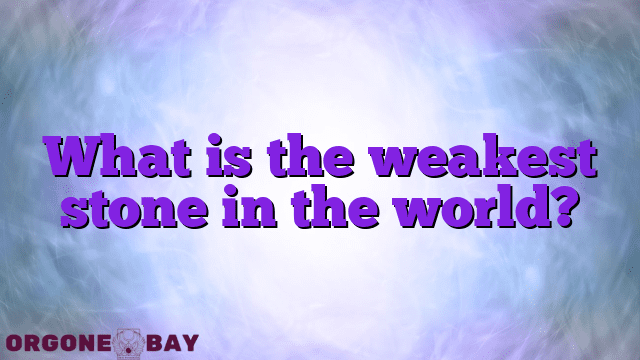Crystal Myths Controversies & Misconceptions
What is the weakest stone in the world?
The weakest stone in the world, according to the Mohs Scale of Hardness, is talc. This mineral has a score of 1 on the scale, making it the softest and most fragile stone. It is so soft that it can easily be scratched by common objects such as fingernails or even a piece of paper.
Here are some interesting facts about talc:
• Talc is a mineral that is commonly used in baby powders and cosmetics due to its ability to absorb moisture and provide a silky smooth texture.
• Talc is often found in metamorphic rocks and is formed from the hydration and alteration of magnesium-rich minerals.
• It was once believed that talc had magical powers and was used in ancient Egypt for its healing properties.
Although talc may be the weakest stone on the Mohs Scale of Hardness, it still holds great value and importance in a variety of applications. From its use in personal care products to industrial applications, this mineral continues to be an integral part of our daily lives.
Table Of Contents
The Weakest Stone in the World
The weakest stone in the world is talc, which stands at the bottom of the Mohs Scale of Hardness. It is a mineral composed of hydrated magnesium silicate and is widely used in cosmetic and personal care products due to its softness and absorbency. While talc is used in many household items, it is often overlooked that it is also the most vulnerable to being scratched or damaged.
The Mohs Scale of Hardness
The Mohs Scale of Hardness is a system used to rank minerals based on their relative hardness, with the hardest mineral at the top of the scale and the softest at the bottom. Developed in 1812 by Friedrich Mohs, the scale consists of ten minerals, with talc at the bottom with a rating of 1 and diamond at the top with a rating of 10.
The Mohs Scale is essential for identifying and selecting minerals for various applications. It is particularly important for industrial and construction purposes where the hardness of a mineral is critical for determining its suitability for cutting, polishing, and drilling.
Understanding the Mohs Scale of Hardness
The Mohs Scale of Hardness is a relative system that ranks minerals based on their ability to scratch the surface of other minerals. A higher number on the Mohs Scale indicates a higher level of hardness and durability, while a lower number means the stone is softer and more prone to scratches.
It is important to note that the Mohs Scale of Hardness is not a linear scale, meaning that the difference between the levels is not equal. For example, a diamond is not simply twice as hard as a mineral rated 5 on the scale. In fact, diamond is so hard that it is often used to cut and engrave other minerals.
The Hardness of a Diamond: Mohs Scale
At the top of the Mohs Scale of Hardness is diamond, rated at 10. Diamonds are the hardest naturally occurring mineral and are widely used in jewelry due to their durability and brilliance. They are also used in various industrial applications, including cutting and polishing tools, because of their ability to withstand high temperatures and pressures.
In terms of hardness, diamond is significantly harder than any other mineral on the scale. In fact, it is so hard that the only way to scratch or damage it is with another diamond.
Fluorite: Vulnerability to Scratching
Fluorite is one of the minerals rated four on the Mohs Scale of Hardness. While it is significantly harder than talc, it is still quite vulnerable to scratches and damage. A knife can easily scratch the surface of fluorite, making it unsuitable for industrial applications.
Fluorite is widely found in nature and is used for various decorative and ornamental purposes. Its unique properties, including its fluorescent and luminescent qualities, make it a favorite among collectors and geologists.
Calcite: Prone to Scratches by Copper
Calcite is rated three on the Mohs Scale of Hardness and is more durable than talc and fluorite. It is often found in nature and is used in various industrial applications. However, calcite is still prone to scratches and damage, particularly by copper.
A copper coin can easily scratch the surface of calcite, making it unsuitable for applications that require high levels of durability and resistance to damage.
Gypsum: Brittle Nature
Gypsum is rated two on the Mohs Scale of Hardness and is one of the softest minerals found in nature. It has a unique property of being able to harden and solidify when water is added, making it a popular construction material.
However, gypsum is brittle and prone to cracking, making it unsuitable for applications that require high levels of durability and resistance to damage.
Talc: Easily Scratched with a Fingernail
At the bottom of the Mohs Scale of Hardness is talc. Talc is one of the softest minerals found in nature and is vulnerable to scratches, even by a fingernail. It is widely used in cosmetic and personal care products as well as in talcum powder.
Due to its vulnerability to scratches and damage, talc is unsuitable for industrial and construction purposes that require high levels of durability and resistance to damage.
In conclusion, the Mohs Scale of Hardness is an essential system used to rank minerals based on their relative hardness and durability. The weakest stone in the world, talc, is at the bottom of the scale, and it is easily scratched and damaged. On the other hand, the hardest naturally occurring mineral, diamond, tops the scale and is incredibly durable and commonly used in various industrial applications. Understanding the Mohs Scale of Hardness is crucial for selecting minerals for different applications.

